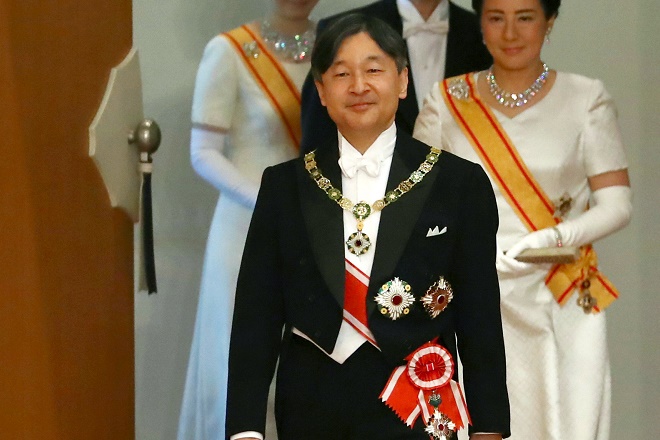Emperor performs 1st palace ritual after enthronement
May 8, 2019
Tokyo--Japan's new Emperor Naruhito on Wednesday performed his first sacred ritual in the Imperial Palace after he ascended the throne May 1.
In the "Kijitsu-Hokoku-no-Gi" ritual at the Imperial Sanctuaries, Emperor Naruhito reported to his ancestors the dates of key Imperial succession-related events slated for autumn.
The day's ceremony was also attended by Empress Masako and other members of the Imperial Family, including Crown Prince Akishino and Crown Princess Kiko, as well as by the heads of the three branches of government, including Prime Minister Shinzo Abe, and local government representatives.
Emperor Naruhito ascended the throne the day after his father, Emperor Emeritus Akihito, abdicated April 30.
In the ritual, Emperor Naruhito appeared at Kashikodokoro, one of the sanctuaries, which enshrines sun goddess Amaterasu-Omikami, the Imperial Family's ancestral deity, shortly past 10:30 a.m. (1:30 a.m. GMT).
Wearing for the first time "Korozen-no-Goho," a traditional costume exclusively for the holder of the Chrysanthemum Throne, Emperor Naruhito walked around the corridor with chamberlains who held the sacred sword and jewels.
After entering the inner sanctuary, he bowed in worship and read an "Otsugebumi" address to report that the biggest Imperial succession-related event, "Sokuirei-Seiden-no-Gi," to proclaim his enthronement, will be held on Oct. 22 and that he will perform "Daijosai," his first thanksgiving ceremony after the enthronement, in which he will pray for the well-being of the people and a good harvest, on Nov. 14-15.
The Emperor performed similar acts at the other two sanctuaries--Koreiden, where the departed souls of past emperors and Imperial Family members are enshrined, and Shinden, which enshrines various gods from across the country.
Empress Masako, dressed in a traditional costume, also performed acts of worship at the three sanctuaries. She visited all of the three for the first time since December 2002, when she was crown princess.
In the "Chokushi-Hakken-no-Gi" ritual in an Imperial Palace state room later Wednesday, Emperor Naruhito dispatched envoys to Ise Jingu, a Shinto shrine complex in Mie Prefecture, central Japan, the mausoleum of Emperor Jinmu, his mythical earliest predecessor, in Nara Prefecture, western Japan, and the mausoleums of the four most recently deceased emperors, including Emperor Hirohito, posthumously called Emperor Showa.
Following precedent, the government decided that the costs of the enthronement-related events be covered with public funds managed by the Imperial Household Agency, not with private funds of the Imperial Family.
Meanwhile, the private funds were used to cover costs for ceremonies related to the abdication of Emperor Emeritus Akihito, excluding those performed as Imperial acts in matters of state.] Jiji Press
Latest Videos
- THE UNTOLD STORY EXPERT INSIGHTS INTO THE UKRAINE
- NEGOTIATING A NEW ORDER US RUSSIA TALKS ON UKRAIN
- Ukraine: A Pawn in the Geopolitical Game? Will Trump Intervene?
- US VP VANCE CRITICIZES EUROPEAN DEMOCRACIES AT MUNICH SECURITY CONFERENCE
- UNCOVERING THE WEB OF DECEIT: CIA INFILTRATION OF THE MEDIA
- SHIFTING SANDS: TULSI GABBARD’S CONFIRMATION AND THE EVOLVING GLOBAL LANDSCAPE
- FAUCI SCANDAL: A THREAT TO GLOBAL HEALTH AND DEMOCRACY






